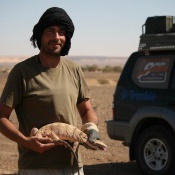Nuclear gene genealogies, landscape genetics and GIS: developing an integrated approach to test hypotheses on the biogeography of Iberian herpetofauna
Phylogeography is undergoing a fundamental conceptual and methodological shift. First, because after many years of relying on the sole use of the non-recombining mtDNA molecule, there is now a growing tendency to explore the nuclear genome, a virtually unlimited source of genetic markers. Second, because the parallel development of molecular techniques and the increasing capacity of computers to handle multiple environmental and climatic data in spatially explicit contexts resulted in the emergence of the new field of landscape genetics.Finally, because of the progressive transition from simple descriptions of patterns of genetic diversity and associated ad-hoc explanations, to rigorous consideration of different scenarios and statistical testing of various hypotheses. In the last few years, the phylogeographical analysis of multiple amphibian and reptile species in the Iberian Peninsula revealed remarkable patterns of population fragmentation, expansion and admixture, reinforcing the importance of this Southern European refugium as both a hotspot and melting pot of genetic diversity. However, in most cases, inferences on the history and demography of species were severely limited due to the single use of mtDNA. On the other hand, modelling of species distributions in Iberia have been made from environmental and climatic data and showed considerable potential to predict future distributions under scenarios of global change or to simulate paleoclimates and identify potential refugia. This project aims to promote an integrative approach to the historical biogeography of Iberian herpetofauna by combining the use of multiple nuclear gene genealogies in a landscape genetics context. We expect that this approach will accommodate a wide range of demographical and biogeographical processes that can be explicitly tested in a rigorous statistical framework. The project is divided in three parts. In the first part we will select a representative set of Iberian amphibians and reptiles for which comprehensive phylogeographic scenarios have already been described and analyse them for a minimum of five independent nuclear gene genealogies. Following a Landscape Genetics approach, individuals will be the operational units of study. This choice will avoid the a priori choice of populations and will allow a much higher resolution of inference processes. In the second part we will develop new analytical tools for determining spatial genetic patterns from the data and correlate it with landscape or environmental features. Finally, the third part will be dedicated to the specification of alternative historical and demographical scenarios and corresponding statistical testing. In fulfilling these goals, we expect to reveal the complexity of the evolutionary processes that shaped the present-day genetic architecture of amphibians and reptiles in the Iberian Peninsula and at the same time contribute to the merging of research fields that have traditionally been kept apart.
Eduardo José de Frias Gonçalves Crespo, João Miguel de Barros Alexandrino, José Alberto Álvares Pereira Gonçalves


